Estimated reading time: 15 minutes.
July/2018 – The EF 300mm f/2.8 L IS II USM is the second generation of Canon’s large aperture, stabilized telephoto lens. Bigger than the EF 200mm f/2 L IS USM we’ve already seen, and smaller than only the SUPER-telephoto lenses from 400mm and up, it’s a 2011 update to the first 1999 “image stabilizer” prime, that itself took the place of the non-IS version of 1987; all part of Canon’s highest quality primes. Made to shoot subjects at a distance with the highest demand of exposure, they’re essential on most professional sports, landscapes and fashion photographers kits, but added to my personal kit due to the demand of extra resolution from the EOS 5DS. It will take the place of the EF 70-300mm f/4-5.6 L IS USM telephoto lens that can barely deliver the performance asked by the camera. But was it worth the update? Let’s find out on this review! Nice reading.
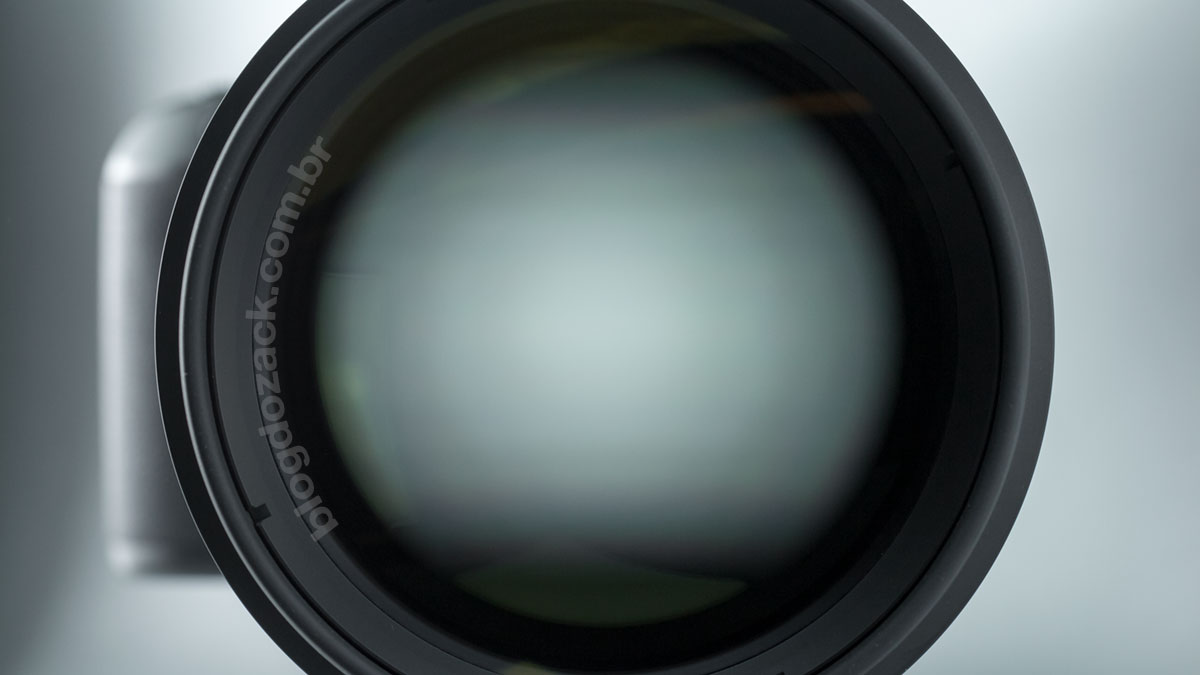
At 24.8 x 12.8cm of 2.350 grams of mostly metals and glasses, I don’t even have to mention the EF 300mm f/2.8 L IS II USM is a large lens; part of Canon’s top-of-the-line telephoto primes. Made to support the demands in performance from large optical pieces, mechanical robustness and the professional market’s everyday needs, actually the manufacturer made this Mark II lighter and practical than ever. The secret is the removal on the first optical element – a mere protector on the prior generation – for a 13% lighter lens; easier to use than even the 200F2. That’s why the 300mm f/2.8 II is so popular on the EF lineup: it’s “the last” lens capable of being handheld, without the assistance of a tripod for dynamic compositions, and the main reason to add it to your kit; no other large aperture prime is so easy to use by itself or together with extenders (1.4x 420mm f/4 equiv.; 2x 600mm f/5.6 equiv.); being the ultimate telephoto lens for photographers on the go.
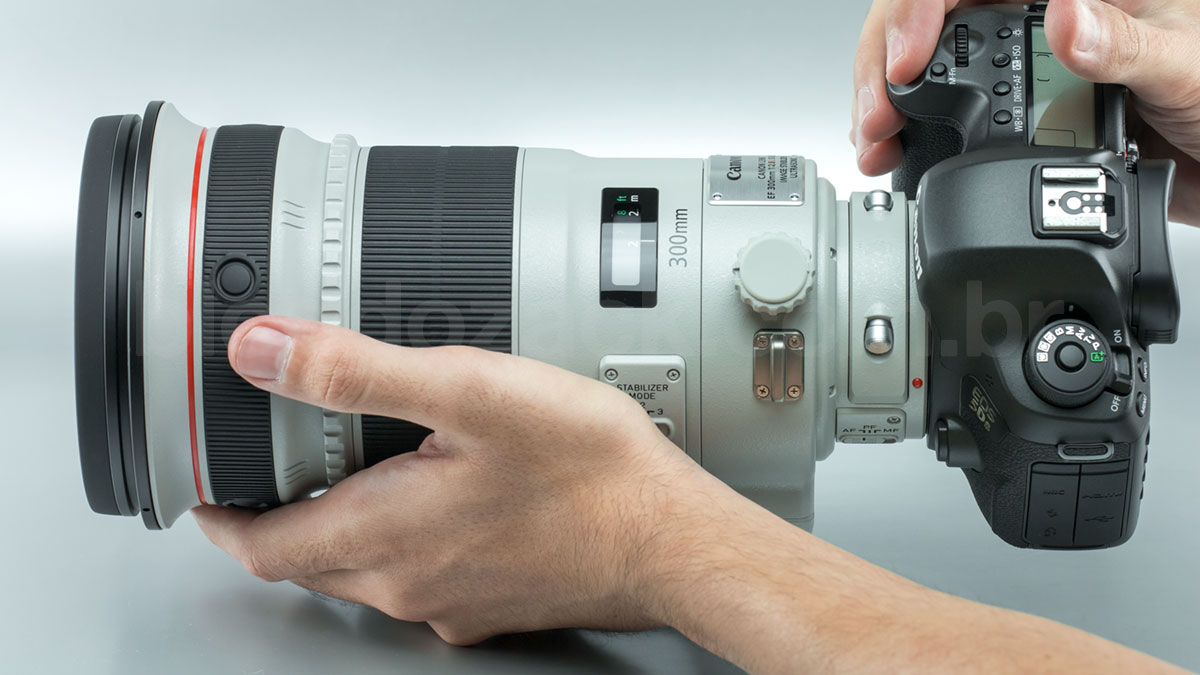
In your hands the EF 300mm f/2.8 L II is obviously large, although incredibly well balanced; it’s as easy to use as an EF 70-200mm f/2.8 L II IS USM. Here shown with the EOS 5DS, for example, the camera + lens combo perfectly balances on the lens non-removable tripod collar, not “pushing” the set to the front for perfect viewfinder shooting; all in your hands. The left hand sits on a fixed metal barrel at the middle of the lens, and it separates the 300mm seven (!) zones: (1) manual focus; (2) focus preset and (3) focus-off at the front; (4) stabilization and preset switches in the middle; (5) tripod collar and foot; (6) filter slot and (7) auto-focus at the back. So it seems hard to read on a blog post, but that’s reality: there’s nothing really special on the 300mm f/2.8 usability, and everything is in its right place, as any Canon lens. Who would say the 300mm were so mundane?
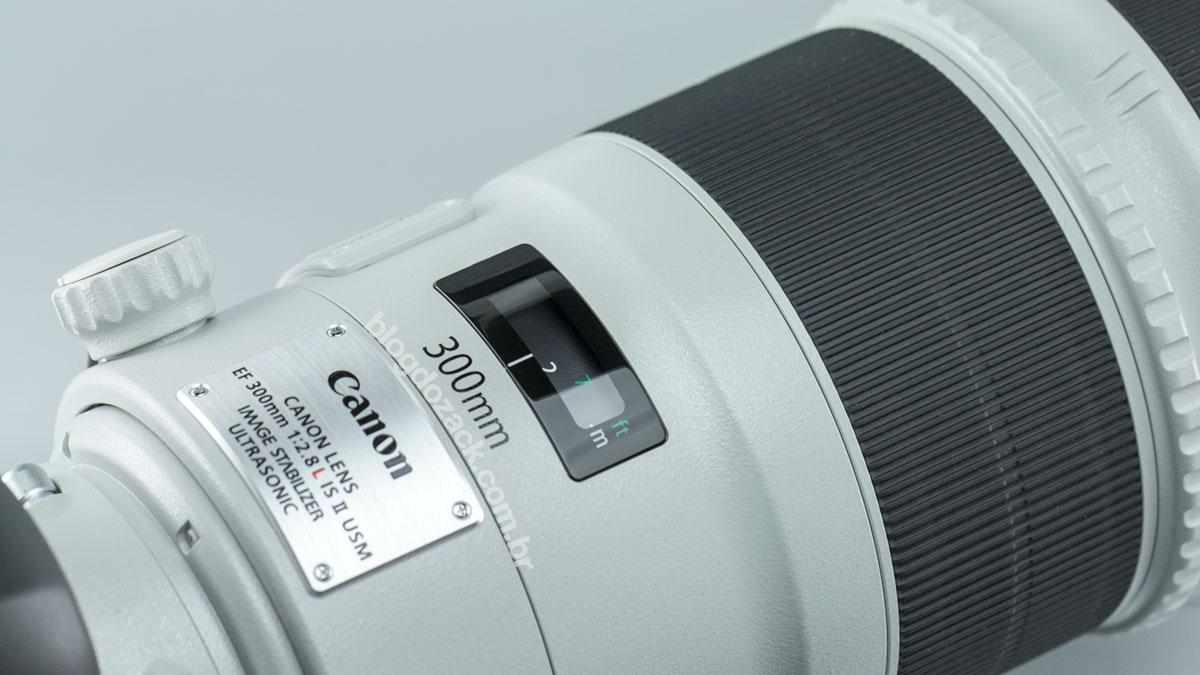
The manual focusing ring is precise with no “play” between the external movement and the internal parts; and it is giant for a comfortable grip. The rubberized ring features raised grooves to enhance friction, also transmitting the perfectly damped torque response from the internal groups; perfect for precise adjustments. The complete 2m to infinity focusing turn goes at about 210º, impossible to be quickly adjusted, but mandatory for its precision; challenging from the longer focal length & the large aperture spec. The focusing is also completely internal and central, not expanding the lens, and offers a big distance windows with feet and meter markings; all with the advanced “full time manual” operation. Even with the AF mode selected on the rear switch it is possible to compensate for the focusing distance using the ring, making it faster to adjust focus.

At the front we have a thin and metallic ring that is exclusive to Canon’s telephoto lenses, called “preset ring” (found from the EF 200mm f/2L IS USM and up). Different from the focusing ring, the preset works with a much shorter 2º turning angle limited from both sides (it doesn’t rotate indefinitely), using a spring loaded mechanism to return to zero. The camera “understands” this ring with both direction and pressure controls, activating the focusing motor with two functions. The first is called preset and allows the photographer to record a distance on the lens memory, using the SET button and quickly recalling it using the ring; perfect for events when the photographer knows the subject’s position, like in a fashion catwalk or the players on field sports. Then we get instant focus prior to shooting, without the camera’s calculations on where to focus.
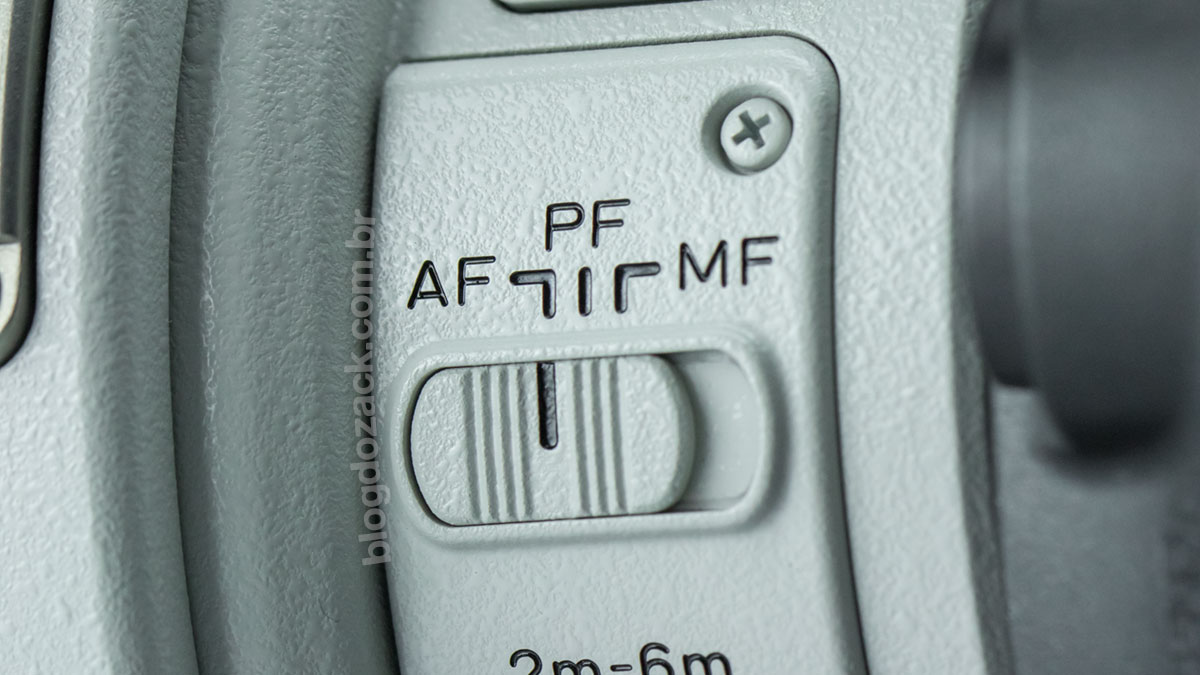
And the second function was introduced on this lens, together with the 400mm f/2.8 II, and is called “powerfocus”; used during video recording. Activated by the switch’s PF position, the idea is to use the ring to send a motorized command to the focusing group for smoothly control the distance for creative focus pull effects; without an extra SERVO motor; for professional results. While the focusing speed is limited to just two settings, faster or slower, it’s much better than manually focusing by hands; that hardly looks smooth. And finally at the front Canon offers four extra buttons on the lens barrel that can be programmed to a few functions. They can be used to prevent the camera from autofocusing when the photographer decided to keep the AF+AE functions together on the shutter release button; a good idea to work with larger, heavier lenses. So everything is as flexible as possible, made to serve every job at hand.
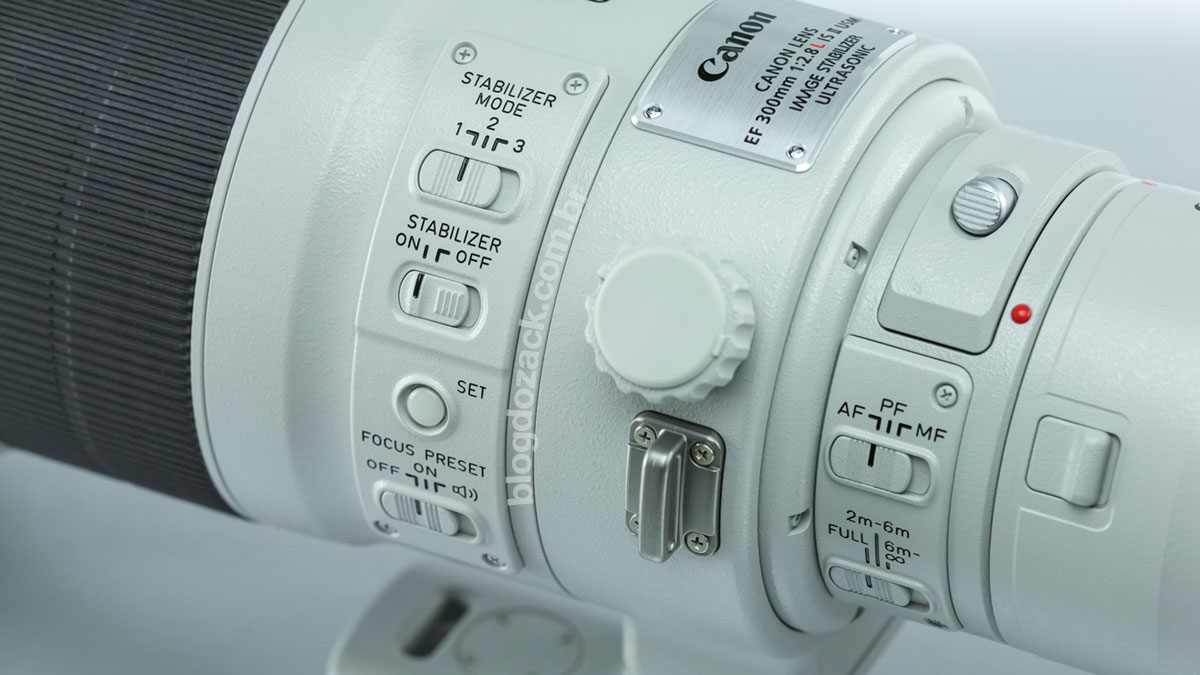
Inside Canon employs it’s excellent USM focusing motor on the EF 300mm f/2.8 L IS II USM; a market’s favorite since its introduction in the 80’s. Mounted around the internal focusing groups, two magnetic rings generates force to move the glasses front and back on spiraled tracks, focusing the lens and keeping the optical alignment for longer; all with maximum torque and near absolute silent. Although it’s not the fastest focusing motor we’ve seen from Canon at this focal length – the new EF 70-300mm f/4-5.6 IS NANO-USM is much faster using a linear movement – obviously the EF300F2.8LII is plenty fast for the professional market. Under shorter distances from 2m to 6m, and 6m to infinity (both with limiter switches), its focusing is nearly instant with most EOS cameras. However its precision is not the best, and I felt it extra challenging to focus with the 300mm f/2.8.

“Cyclist” with the EOS 5DS + EF 300mm f/2.8 L II IS USM at f/2.8 1/1000 ISO500.
Let’s make one thing clear: there’s nothing wrong with the EF 300mm f/2.8 L II USM focusing capabilities. The new algorithm is better at deciding between finer or sharper changes in focus, depending of your subjects distance and, paired with the 1.4X and 2X third-generation converters, apparently there’s no loss in AF performance. The focus is reliable, fast and precise (no Micro-Adjustment required) at least with Canon’s latest cameras. But the longer focal length and the large aperture were surprisingly difficult to focus due to the shallower depth of field; it felt as hard to nail focus as a specialty EF 85mm f/1.2 L II USM. So any photographer’s movement or body imbalance can take the sharpness out of wide aperture shots, and I noticed far more out-of-focus images than I was expecting from the 300F2.8LII. So it’s worth some appreciation for more experienced photographers: those incredible 300mm f/2.8 images are strictly their merit, with perfect technique and lots of patience; a top-of-the-line lens is worth nothing on amateurs hands.

“Cyclist II” with the EOS 5DS + EF 300mm f/2.8 L II IS USM + EF 2X III at f/5.6 1/1000 ISO2000 @ 600mm.
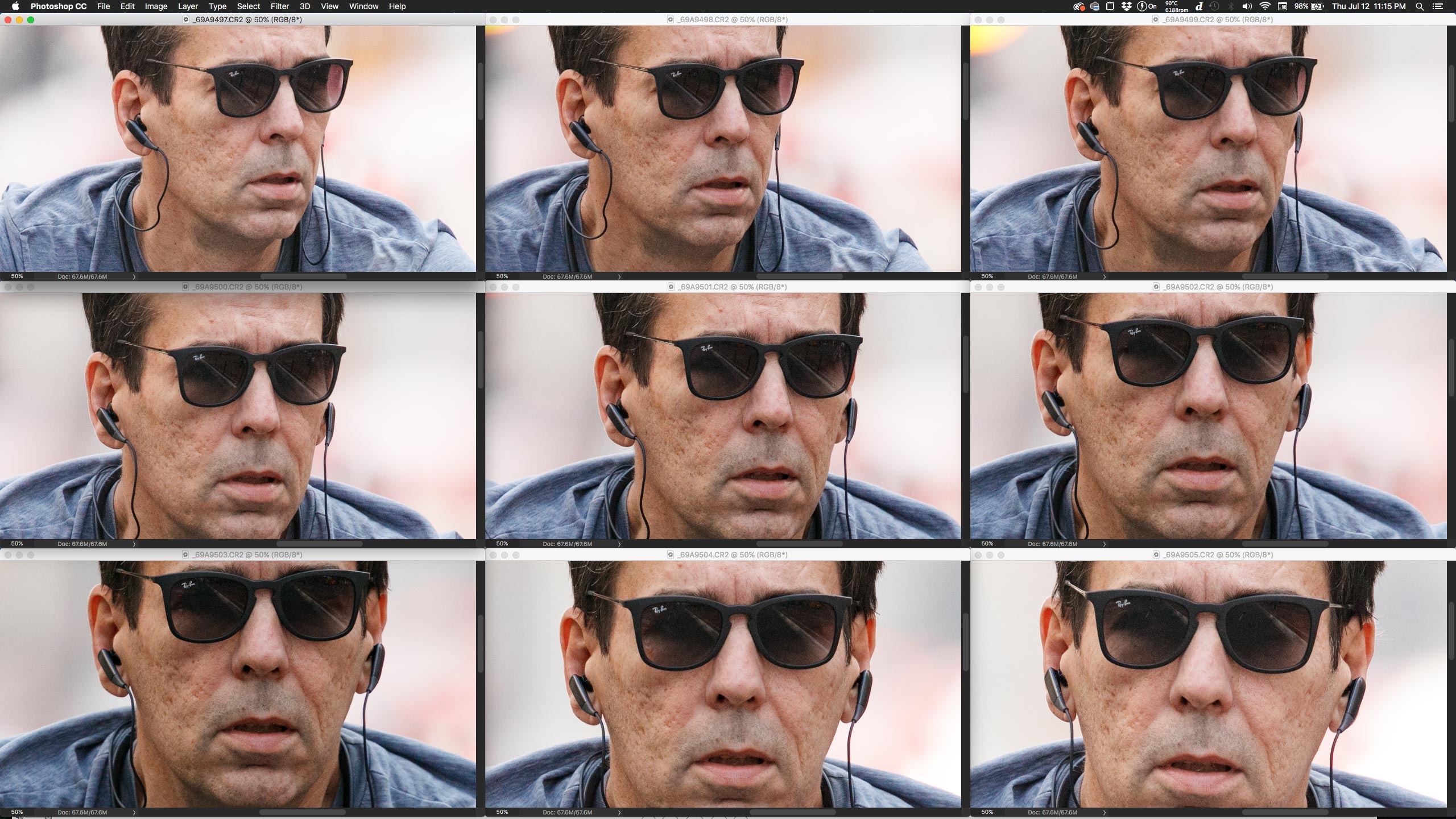
Crop 50%, AI SERVO performance is impressive even using the converter, with no loss in speed. (click for larger)
During SERVO operation the performance is scary good in a positive way. Tested on the EOS 5DS’s AF SERVO III system with programmable speed, precision and priority algorithm, the continuous shot focusing accuracy is nearly 100%, that’s incredible to say the least. To shoot Avenida’s Paulista cyclists the EF300F2.8LII shows no difficulty in seeking, following and predicting the subjects distance, impressive to even feel the large glass elements torque forcing the focusing groups back and forth. And paired with Canon’s EF Extender 2X III and the resulting 600mm f/5.6 focal length and aperture, the AF performance is also nearly flawless, with 100% accuracy on this newest Mark III generation. So once again we’re reminded of the 300F2.8LII popularity: it can be a 420mm f/4 (1.4X) and a 600mm f/5.6 (2X), eliminating the purchase of larger lenses.

Crop 100%, an out-of-focus shot showcasing the challenges in focusing such a shallow depth of field.
Another mandatory Canon telephoto feature is the built-in stabilizer, invented on the 1980 EF 70-300mm f/4-5.6 IS USM. Virtually adopted on every telephoto EF lens ever since (with rare exceptions), the IS module got better from each generation enhancing it’s operation an effectiveness. On the 300mm f/2.8 Mark II it’s almost the latest generation featuring an up-to 4-stops (EV) compensation at f/2.8, with dedicated modes for both axis (mode 1), panning (mode 2) and the new exposure-only mode 3; better for action shooting. A forth automatic mode detects the tripod and compensates for the camera’s mirror slap, and it all works internally as quietly as possible; also great for video recording. But just as the auto-focus the stabilizer is not as reliable, and once again there’s a learning curve to make the best of its performance.
Once again don’t get me wrong: the EF 300mm f/2.8 L II IS USM stabilizer is state-of-the-art and one of the best on the telephoto’s market. Based on the same EF 200mm f/2 L giant module – Canon’s only lens rated at up-to 5-stops – the longer 300F2.8II should compensate for 1/180 (-1EV), 1/90 (-2EV), 1/45 (-3EV) and 1/20 (-4EV), for absurdly long exposures. But just as I noticed on the EOS 7D Mark II + EF 70-200mm f/4L IS USM reviews, these recent “high density” cameras offer a new challenge for the sharpest images, with new “rules” of minimum shutter speeds. With the EOS 5DS + lens 3.5kg combo, the 50MP full-frame sensor doesn’t forgive even the strongest photographer: five minutes hand-holding it can make for very shaky arms, so less than 50% of mine 1/80 shots (-2EV) are sharp; reminding us the IS is not really a white-card to shoot like a madman. So I recommend caution shooting with these higher-end cameras: for the best results, carefully adjust your exposure and posture prior to registering high quality shots.

Crop 100%, despite the -1.5EV recommended exposure, the IS didn’t guaranteed a sharp image.
Other improvements are less noticeable on the 300F2.8II, less than the released-at-the-same-time 400F2.8II. The longer lens got a new curved focusing ring that’s smoother to the touch, paired with titanium parts for lightness – pieces missing from the this 300mm Mark II. While the first and last glass elements are fluorine coated for easy maintenance, maybe Canon should consider releasing an even lighter 300mm f/2.8 Mark III. At the center-back the non-removable tripod collar locks in place at 90º (portrait or landscape orientations), and can also be rotated 180º and used as a handle; to easily carry the camera. And the tripod should be attached to the lens’s collar, balancing the camera and not forcing the EF mount; all with an included shoulder strap for easily carrying it.
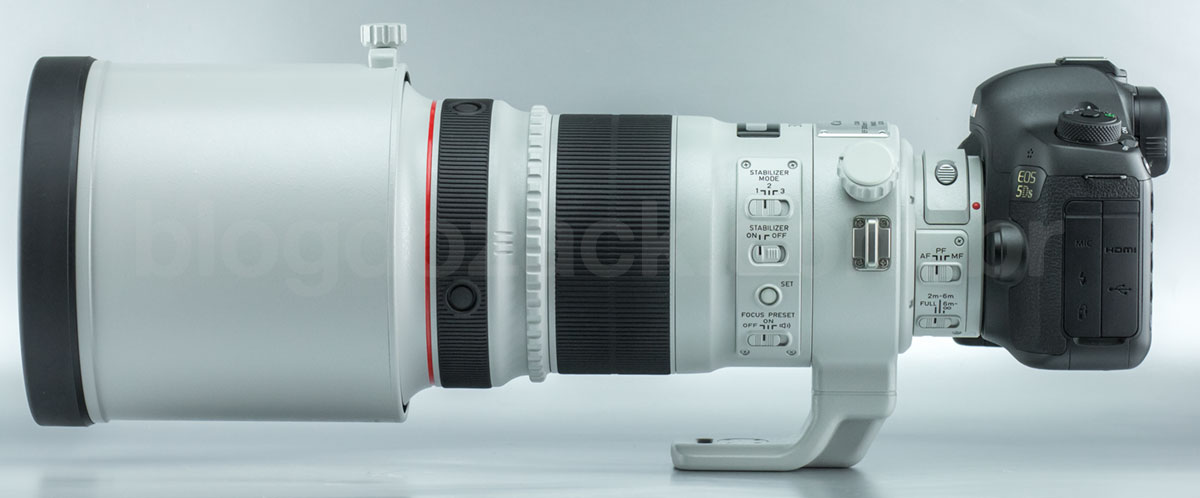
Near the tripod collar fits one of the best filter solutions on the market, with a ø52mm drop-in slot compatible with polarizers and NDs. They fit a rounded spring-loaded clip that sits between the last optical groups, identical on every Canon telephoto prime at this class. This slot is weather sealed against dust and water, and much easier to use than other brands gigantic screw-in filters on the telephoto market (like Sigma’s 150-600mm). And the lens mount supports both EF 1.4X and 2X converters, for 420mm f/4 and 600mm f/5.6 conversions, with impressive AF performance as showed. And Canon’s press release states new and improved weather sealing gaskets around the rings, control switches and mount, making it perfect to match everyday challenges in photography.
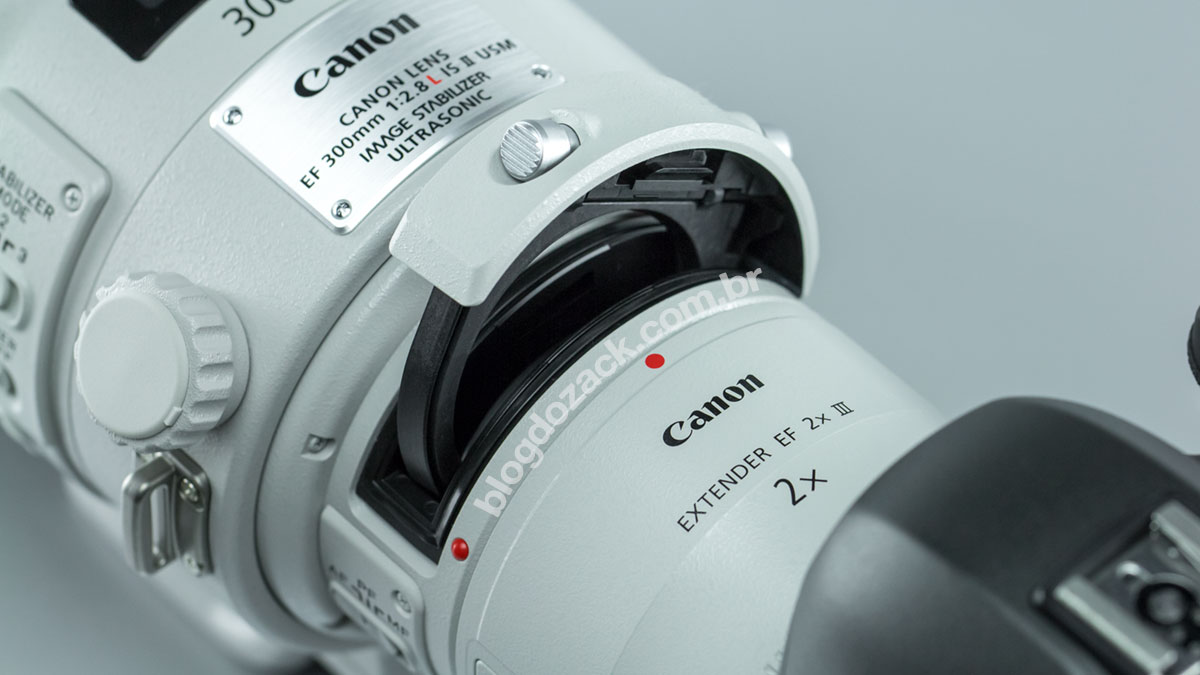
Finally the EF 300mm f/2.8 L II IS USM comes with the standard telephoto accessory kit from Canon’s white primes line-up; as we saw on the EF 200mm f/2. Instead of a soft carrying pouch the 300F2.8 comes with a rigid 300B case, padded against impact. It features a new lateral handle (the 200F2 used a top handle) and stands by its side, more portable to fit tighter spaces. Take good care of this case: it costs US$400 and is a special order on most stores. The included ET-120W II lens hood is also exclusive to this lens and made of carbon fiber, attached to the front of the lens on a dedicated thread, also reversibly mounted when it’s time to put it away. Also take good care of it: it costs a whopping US$499! And the new padded nylon front cover comes in place of the older faux-leather long cover, easier to use at the front of the lens or the lens hood.

What Canon offers on its white-telephoto-primes is more than a top-of-the-line lineup on the professional’s market. It is nearly four decades of expertise with some models at their third generation, with newer and improved focusing and stabilizing technologies; build quality and advanced ergonomics, durability and reliability; always in demand on the professional’s market. The 300mm f/2.8 L II IS USM is at 1/4 of it’s lifetime (it was introduced six years ago) but few brands offer anything similar today, specially considering its price point and further discounts. So it seems absurd to have one on your personal kit, but it is not. Now it’s the time (or it was during the Black Friday’s rebates) to get your hands on one, for the ever-improving digital photography cameras and, as we’ll see from its image quality, maybe this is only lens to be used on newer high-resolution cameras. Is the EF 300mm f/2.8 L II IS USM Canon’s perfect lens?

“S. do Rio do Rastro II” at f/6.3 1/640 ISO250; all photos with the EOS 5DS.
With a simple 16 elements in 12 groups optical formula, with two artificial fluorite glasses and novelty chemical treatments to each glass piece, obviously what Canon delivers on the EF 300mm f/2.8 L II IS USM performance is worthy the professional market. You get what you paid for and the image quality is absolutely impeccable from the widest aperture – the raison d’etre of having this lens on your kit – and mandatory for quality publishing. But not only this lens is good at f/2.8, it raises the bar for the edge resolution, virtually perfect where the 70-300L zoom fails to deliver even at f/8. The aberration control is also flawless, with no colored lines except minimum contrast edges on the out-of-focus planes, visible mainly when we push the optics to its minimum focusing distance. And that’s why you should have the prime: excellent optical performance!

“Serra” at f/4 1/320 ISO640.
Wide open the EF300F/2.8LII performance impresses and is possibly the highest ever tested on blog do zack. Added to my kit in order to flawlessly register landscapes on the EOS 5DS’s 8688×5792 files, the f/2.8 aperture advantage lies on the lower ISO’s after the sun sets. But most importantly the edge performance is enhanced, and I’ll repeat: this f/2.8 prime delivers better wide open performance than the 70-300L zoom at f/8! It’s incredible to see landscapes with plenty of details at f/2.8 and from edge-to-edge, no matter the focusing difficulties from the short depth of field. And this pleasure of use is mandatory for some shots: without the 5DS 50MP and the EF 300mm f/2.8 L II IS USM some of my shots wouldn’t be possible. So it already paid-off to have it on my kit. Genius!
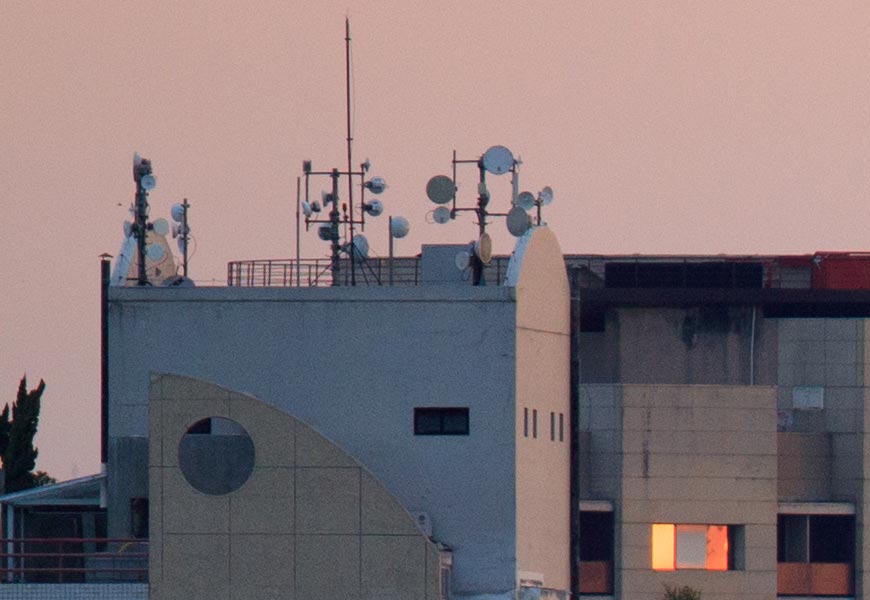
Crop 100%, maximum detail on upper-left corner, perfect.

Crop 100%, wide open perfection, despite the shallower depth of field.

Crop 100%, maximum sharpness on the center frame.
Stopping down merely reduces the vignetting as the long prime barely compresses its depth of field; always short on the telephoto distance. Wide open the 300F/2.8LII shows about -1EV of luminosity loss around the edges, given the physical limitation of its internal pieces, showing a distinct peephole effect on smoother surfaces (walls or the sky); interesting to focus the frame’s attention on the subject; or to enhance the color saturation straight from the camera. But as soon as f/4 and the vignetting is gone, together with some chromatic aberrations, and a slight drop of sharpness close to it’s minimum focusing distance. The rounded 9-blade aperture makes a perfect job in keeping the background smooth, with no strong contrast edges, and better explored for compositions that play with the shallower depth of field.
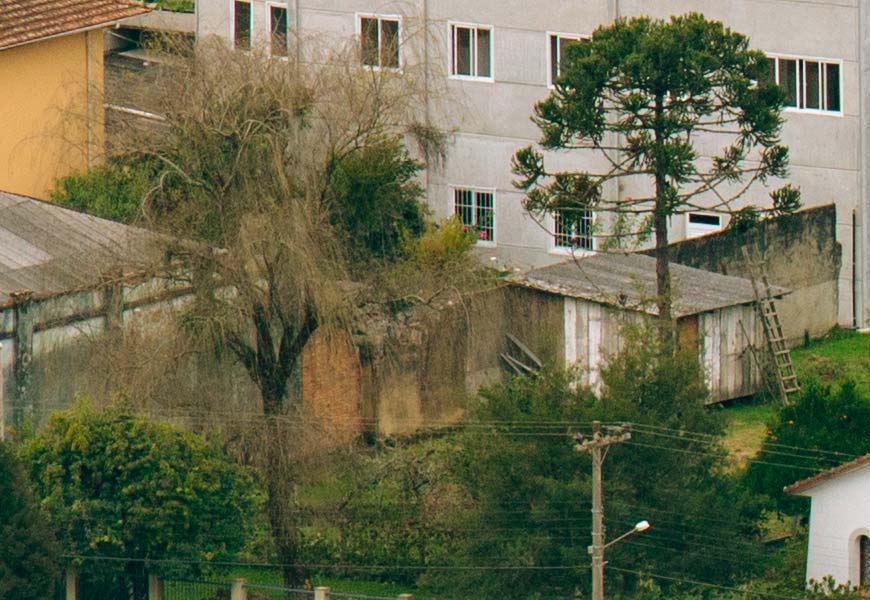
Crop 100%, the optical performance is barely enhanced with a stopped down aperture.
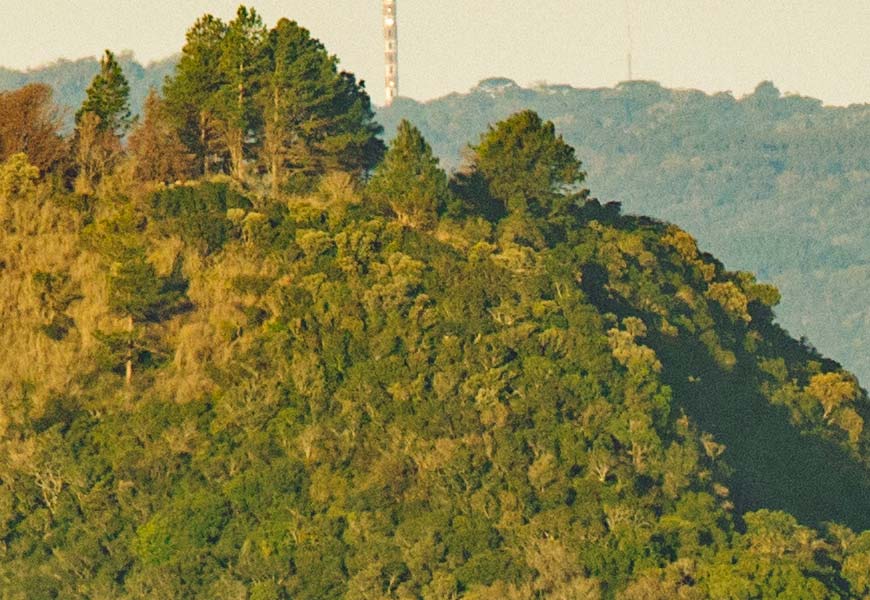
Crop 100%, large format printing possible from the large aperture prime.
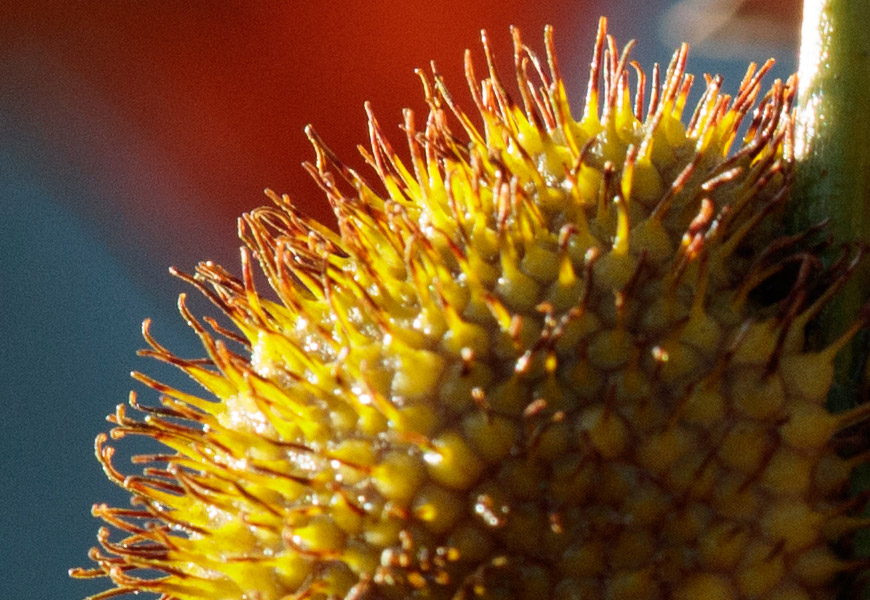
Crop 100%, maximum detail rendering from the shortest focusing distance.
At the minimum focusing distance of 2m the optical magnification stands at 0.18x (non-macro) and we take the formula to its limits; maybe the only scenario not recommended for this prime. Photos of flowers, small birds and details suffer from a slight lack of sharpness due to some light scattering inside the lens (with loss of contrast), and is the worst case scenario to showcase this lens fluorite glasses capabilities. Details from tree branches, feathers and petals CAN get fine green and purple edges on the background, far from the clarity of true macro lenses. But it is interesting to test its limits on vlog do zack’s mundane shots: even the top of the line lenses will render poor results when pushed to its limits, so some technique (and good sense) comes in play for the best results.
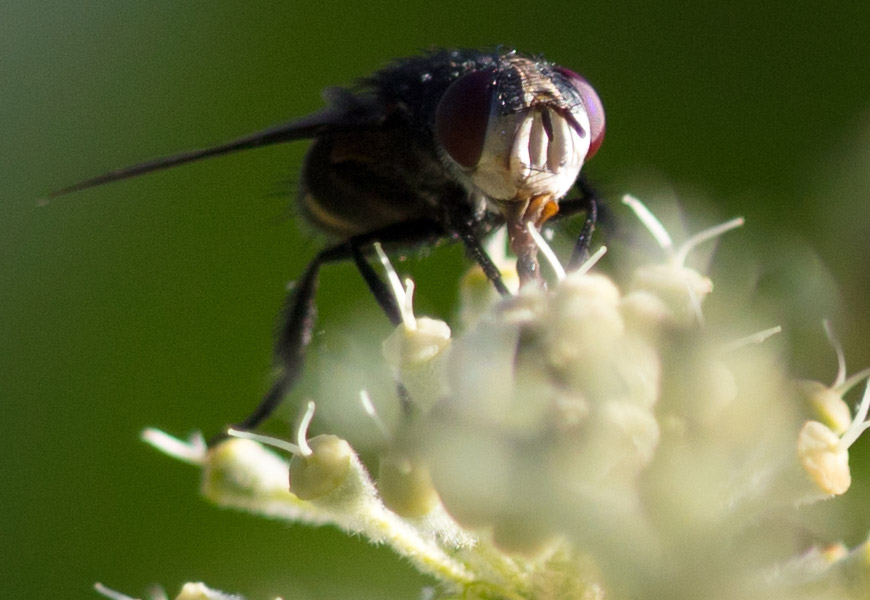
Crop 100%, far from a macro lens, but its performance might please the lesser subjects.

Crop 100%, fine details with minimum axial CA on the background.
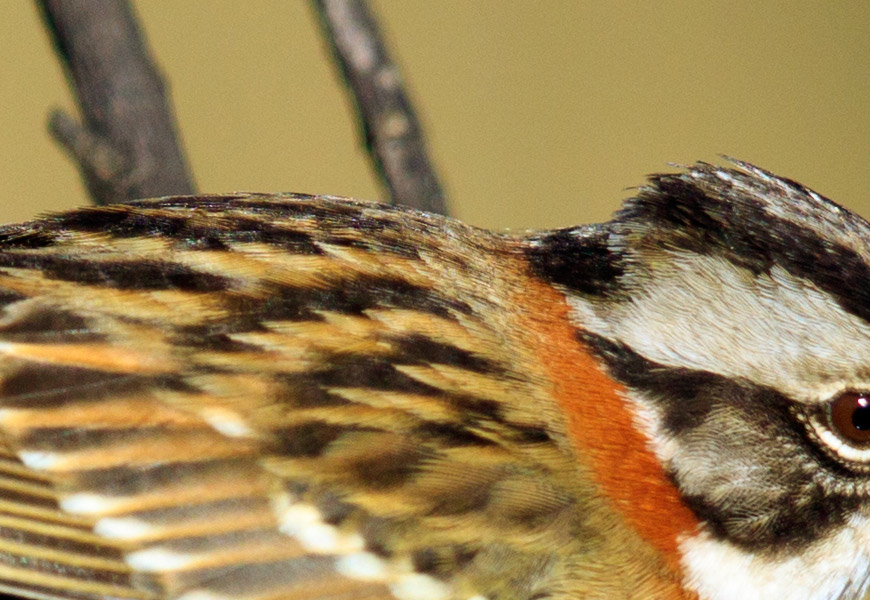
Crop 100%, notice the slight green bubble on the background.
The geometric distortion is also invisible, just like the lateral CA and flaring. And these are the best advantages over the 70-300L zoom, that suffered from both. The new chemical treatments reduced the internal reflections, thus enhancing colors and contrast, from the larger-than-life optical elements of the prime, from better flexibility even when working with harder light schemes; specially when backlit (rim light). But the colors – always the colors – that are the icing on Canon’s digital cake; clearly taking its telephoto design to the limit. It seems easy to get saturated colors from the camera, but it is not. These large format glass pieces can easily bounce light and data from each other, changing the color hue on digital sensors. But Canon masterfully delivers it even on its larger telephoto lenses, with a modern, large aperture architecture; typical of the L series.

“Pôr-do-sol” at f/5.6 1/160 ISO100; Canon’s Subwavelength coating made perfect for larger glass elements.
Finally the use with the EF 2X III converter is exemplary, and the last strike in favor of the EF 300mm f/2.8 L II IS USM. The resulting 600mm focal length looses -2-stops of aperture (f/5.6), for a very similar prime already on Canon’s lineup; the 600mm f/4L II IS USM. The 300mm prime minimum aberrations are magnified with a slight lack of sharpness, enlarged by the EOS 5DS massive 50MP resolution; with edge lateral CA on finer high contrast edges; all easily fixable on Adobe’s Photoshop. Actually it’s easier to “loose” image quality due to the difficulties in shooting faraway subjects over the atmosphere and the camera’s shutter resonance (than can vibrate the sensor) than lens optical shortcomings. So this combo performance is already great to practice with the longer length, maybe even justifying the future purchase of the next large prime lens. We’ll see…
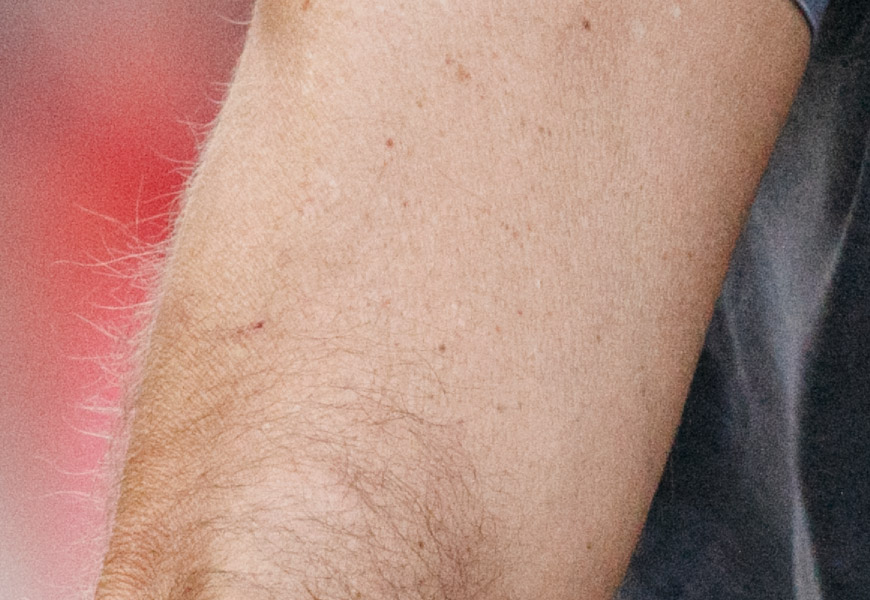
Crop 100%, texture from the subject’s skin, excellent for the wide open aperture.

“Flower” at f/2.8 1/250 ISO100; the out-of-focus quality is not the best, typical of large aperture telephoto primes.
Obviously the EF 300mm f/2.8 L II IS USM performance is the best Canon has to offer, be it mechanically or ergonomically or optically; needing no further recommendation. If you need the highest image quality you’ll certainly find it here, after all the ¥750.000 launch price – the most expensive 300mm in history – didn’t hide Canon’s aim at the professional market. It was made to keep up with recent digital cameras for more resolution like the EOS 5DS, and together it can register files no other camera is capable of. Be it wide open to shoot sports, and lower ISOs under low-light; be it to shoot landscapes with edge-to-edge definition; or to experiment with even longer focal lengths, the 300F2.8LIIIS USM is the half way to Canon’s complete EF lineup from 10mm to 800mm. It paves the way for new kinds of photography on any kit, and it’s totally worth the price, be it for serious amateurs or professionals. Prepare it’s place on your backpack and nice shooting!